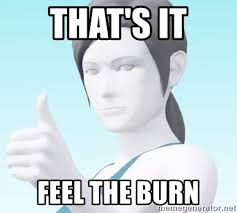Work Out Mayhem
- Cynthia He

- Aug 14, 2019
- 3 min read
By Cynthia He, Anatomy and Physiology
You may have noticed that while exercising is deemed to be good for your body, it may not feel like it is. If you don't typically exercise, the burning sensation during and the dull pain after can cause you to shy away from achieving the toned body you have always wanted. But what causes this to occur?

Actually, there are two different causes for the pain you feel during and after working out: lactic acid and micro-tears in muscle. The first feeling of discomfort during a workout is caused by lactic acid build up. This byproduct of lactic acid fermentation will, quite literally, make you "feel the burn".
Fermentation is a process where glucose is turned into ATP (a molecule that stores power within its bonds, and is the main supplier of energy in the body) without the presence of oxygen - an anaerobic process. There are two types of fermentation: alcoholic and lactic acid. Human muscle cells will go through the latter when lacking oxygen. If not, we would get drunk off of exercising (well, some people wouldn't think that's bad). This means that your body will only go through lactic acid fermentation when it lacks the necessary oxygen to go through cellular respiration. Usually, your body will go through cellular respiration, which produces around 28-36 molecules of ATP, as opposed to lactic acid fermentation, which only produces about 2 molecules of ATP.
Not only is there a drop in energy efficiency, lactic acid fermentation also produces lactate, which combines with hydrogen to make lactic acid, decreasing blood pH. This of course, can cause damage since it is an acid- meaning it releases hydrogen ions that will eat away at the muscle. The acid production caps its use to about 2 minutes before high intensity training cannot be continued.
Obviously, when you work on certain parts of the body (like the infamous leg day), those parts will use up oxygen faster and will go through lactic acid fermentation much earlier. The acid is concentrated in one spot rather than spread out through the body because the muscle cells being used the most is concentrated in one area.
The soreness days after exercising used to be thought of as an after effect of lactic acid production. Later, however, it was found that after a workout and sufficient oxygen is provided, lactic acid is transported to the liver and converted back into pyruvate, where the body can turn it into ATP. Lactic acid does irritate the muscle cells, but it goes away after a few hours. The onset of soreness days later is actually assumed to be caused by micro-tears in the muscle that helps it grow.
The body increases flow of white blood cells to repair the "damage" done by exercising (the microtears), making the muscle swell and inflame. The inflammation will then build up as the body repairs the muscle cells, causing soreness much later (this is known as Delayed Onset Muscle Soreness- DOMS)
Now, this tearing and growing cycle doesn’t apply to all muscle cells. Muscle cells, known as myocytes, are divided into three different types: Skeletal, Cardiac, and Smooth.

Note: Myocyte specialization may be different, but their they also have similarities that only muscle cells would have. For example, muscle cells are generally very long and can connect to create even longer strands of muscle fibers, though the way they connect varies between types of myocytes (see image above). Each myocyte also has multiple mitochondria to supply the constant need for energy.
Human cardiac muscle, found in the heart, cannot regenerate (and leaves behind scar tissue when it dies) because once mammals are born, their cardiac muscles lose the ability to do so. These muscles are fast pace and have great endurance (which is something you want when it comes to you heart!).
Both Smooth and Skeletal muscle can regenerate. Smooth Muscles are involuntary (working without the need for a person to think about moving the muscle), and make up organs like the intestines. Skeletal muscles are attached to bones and work together (in a push-pull relationship) to move limbs. These muscles are under voluntary control, meaning we have the ability to make them move.

So even if you feel like you are suffering from exercise, your skeletal muscles gain tremendously for the work out. Do your best to power through it even if it hurts!





Comments